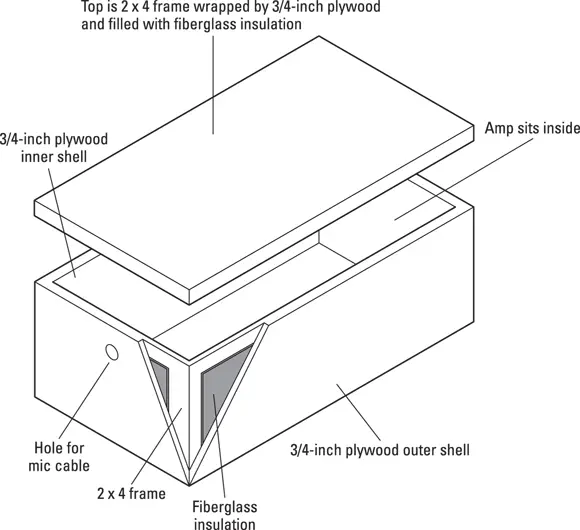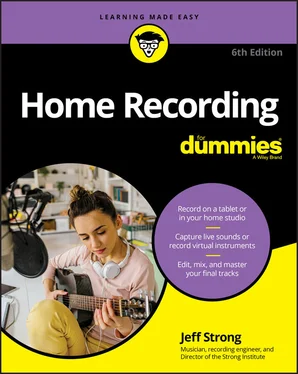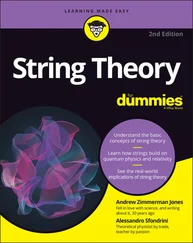If you have a set of near-field monitors (speakers) — the kind that are designed to be placed close to you — they should be set up so that they are the same distance from each other and from you, forming an equilateral triangle (see, high school math has some real-world applications). The monitor’s speakers should also be placed at about the height of your ears.
Figure 3-13 illustrates the best placement for your monitors. Placing your monitors this way ensures that you hear the best possible sound from them and that you can accurately hear the stereo field. (For more on the stereo field, see Chapter 16.)

FIGURE 3-13:Your monitors (speakers) sound best when placed at equal distances from each other and from you.
Your studio probably occupies a corner in your living room, a spare bedroom, or a section of your basement or garage. All these environments are less than ideal for recording. Even if you intend to record mostly by plugging your instrument or sound module directly into the mixer, how your room sounds has a big effect on how well your music turns out.
As a home recordist, you probably can’t create a top-notch sound room. Professional studios spend serious cash — up to seven figures — to make their rooms sound, well, professional. Fortunately, you don’t need to spend near that much money to record music that sounds great. All you need is a little understanding of the way sound travels, some ingenuity, and a little bit of work.
When you start recording in your home, both you and your neighbors are probably concerned about the amount of sound that gets into and out of your room. Sound waves are nasty little buggers. They get through almost any surface, and you can’t do a lot to stop that from happening.
You’ve probably noticed this phenomenon when somebody with a massive subwoofer in his car drives by your house blasting obnoxious music. (Ever notice how someone else’s music is obnoxious whereas your music never is, no matter how loud you play it?) Your windows rattle, your walls shake, and your favorite mug flies off the shelf and breaks into a thousand pieces. Well, this is one of the problems with sound.
The best (and classic) way to isolate your studio room from everything around it is to build a room within a room or to use sound isolation materials to reduce the level of sound passing through your floors, ceilings, or walls. I don’t have the space to go into detail here, but you can find resources to get you started by doing a Google search with the keywords “sound isolation.” Here are a couple places to get you started:
Sound Isolation Company: Aside from selling products to help you keep the sound in (or out) of your studio, you’ll find useful information here about the process of sound isolation.
NetWell: This company sells products to help control sound, but you’ll also find good basic information here to get you started.
If you don’t have the money or space to build a room within a room or to add expensive sound isolation barriers to your recording space, the best thing you can do is to try to understand what noises are getting in and getting out and deal with those noises. For example, if you live in a house or apartment with neighbors close by, don’t record live drums at night. You could also consider using a drum machine or electronic drum set instead.
Another idea is to choose a room in your house or apartment that is the farthest away from outside noise (an interior room, for instance). Basements also work well because they’re underground, and the ground absorbs most of the sound. Placing a little fiberglass batt insulation (the typical house insulation that you can find at your local home center) in the ceiling can isolate you pretty well from your neighbors. Detached garages are generally farther away from other buildings, so sound has a chance to dissipate before it reaches your neighbors (or before your neighbors’ noise reaches your garage).
Also, keep the following points in mind when trying to isolate your studio:
Dead air and mass are your friends. The whole concept of a room within a room is to create mass and dead air space so that the sound is trapped. When you work on isolating your room, try to design in some space that can trap air (dead air) — such as a suspended ceiling or big upholstered furniture — or use double layers of drywall on your walls (mass).
Don’t expect acoustical foam or carpet to reduce the noise. Using these items helps reduce the amount of sound that bounces around inside the room, but acoustical foam or carpet does little toward keeping the sound in or out of the room.
Isolate the instrument instead of the room. Isolating the sound of your guitar amp can be much less expensive than trying to soundproof your whole room. Most commercial studios have one or more isolation booths that they use for recording vocals and other acoustic instruments. You can use that concept to create your own mini isolation booths.
 One idea for a truly mini isolation booth is to make an insulated box for your guitar (or bass) amp. If you just have to crank your amp to get the sound that you want, you can reduce the amount of noise that it makes by placing it inside an insulated box. Check out Figure 3-14 to see what I mean.
One idea for a truly mini isolation booth is to make an insulated box for your guitar (or bass) amp. If you just have to crank your amp to get the sound that you want, you can reduce the amount of noise that it makes by placing it inside an insulated box. Check out Figure 3-14 to see what I mean.
You can also create an isolated space in a closet by insulating it and closing the door when you record, or you can put your guitar amp (or drums) in another room and run a long cord from there to your recorder. If you do this, remember that for long cord runs, you need to use balanced cords; otherwise, you may get a bunch of noise and your signal may be too low to record well.

FIGURE 3-14:An amp-isolator box reduces the amount of noise you hear from your amp, even when it’s cranked.
After you create a room that’s as isolated from the outside world as possible, you need to deal with the way sound acts within your room.
Sound travels through the air in the form of waves. These waves bounce around the room and cause reflections (reverberations or echoes). One of the problems with most home studios is that they’re small. And because sound travels very fast (about 1,130 feet per second — the exact speed depends on the humidity in the environment), when you sit at your monitors and listen, you hear the reflected sound as well as the original sound that comes out of your speakers. With big rooms, you can hear the original sound and reflections as separate sounds, meaning that the reflections themselves become less of a problem. For a good home studio, you need to tame these reflections so that they don’t interfere with your ability to clearly hear the speakers.
 How all these reflections bounce around your room can get pretty complicated. Read up on acoustics (the way sound behaves) to discover more about different room modes: axial (one dimension), tangential (two dimensions), and oblique (three dimensions). Each relates to the way that sound waves interact as they bounce around a room. Knowing your room’s modes can help you come up with an acoustical treatment strategy, but very complicated formulas are used to figure out your room’s modes, especially those dastardly tangential and oblique modes.
How all these reflections bounce around your room can get pretty complicated. Read up on acoustics (the way sound behaves) to discover more about different room modes: axial (one dimension), tangential (two dimensions), and oblique (three dimensions). Each relates to the way that sound waves interact as they bounce around a room. Knowing your room’s modes can help you come up with an acoustical treatment strategy, but very complicated formulas are used to figure out your room’s modes, especially those dastardly tangential and oblique modes.
Читать дальше


 One idea for a truly mini isolation booth is to make an insulated box for your guitar (or bass) amp. If you just have to crank your amp to get the sound that you want, you can reduce the amount of noise that it makes by placing it inside an insulated box. Check out Figure 3-14 to see what I mean.
One idea for a truly mini isolation booth is to make an insulated box for your guitar (or bass) amp. If you just have to crank your amp to get the sound that you want, you can reduce the amount of noise that it makes by placing it inside an insulated box. Check out Figure 3-14 to see what I mean.
 How all these reflections bounce around your room can get pretty complicated. Read up on acoustics (the way sound behaves) to discover more about different room modes: axial (one dimension), tangential (two dimensions), and oblique (three dimensions). Each relates to the way that sound waves interact as they bounce around a room. Knowing your room’s modes can help you come up with an acoustical treatment strategy, but very complicated formulas are used to figure out your room’s modes, especially those dastardly tangential and oblique modes.
How all these reflections bounce around your room can get pretty complicated. Read up on acoustics (the way sound behaves) to discover more about different room modes: axial (one dimension), tangential (two dimensions), and oblique (three dimensions). Each relates to the way that sound waves interact as they bounce around a room. Knowing your room’s modes can help you come up with an acoustical treatment strategy, but very complicated formulas are used to figure out your room’s modes, especially those dastardly tangential and oblique modes.










